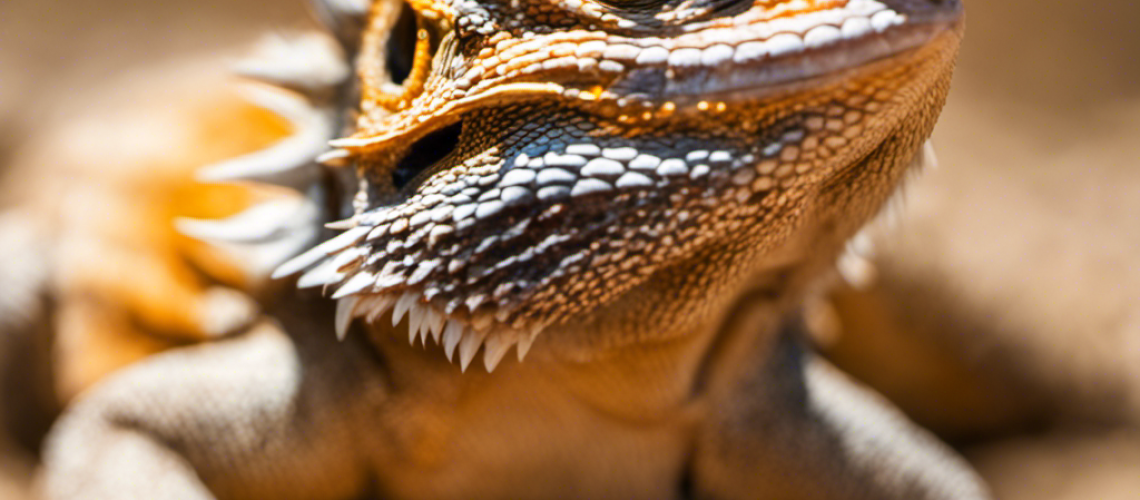Bearded dragons are a popular reptile kept as pets. Many owners want to breed their pet, and preparation is key for successful breeding. There are certain steps that must be taken in order to ensure that the process goes smoothly.
This article will provide an overview of how to prepare your bearded dragon for breeding season. It will discuss choosing a suitable partner, creating an environment conducive to mating, establishing proper nutrition, monitoring stress levels, and stimulating breeding behavior.
Key Takeaways
- Choose a suitable breeding partner based on dietary requirements and temperature regulation
- Create a suitable environment with the correct habitat, heat, humidity, and shelter
- Establish proper nutrition with a balanced diet and vitamin supplementation
- Monitor stress levels and provide ample hiding spaces to reduce stress
Choosing a Suitable Breeding Partner
Choosing a suitable breeding partner is an important step in preparing bearded dragons for the breeding season. To ensure successful mating, it is essential to consider both dietary requirements and temperature regulation of both individuals.
Bearded dragons require UVB lighting and temperatures between 80-90°F during the day and 70-75°F at night, with access to basking spots reaching 95°F. Additionally, they must have adequate calcium levels in their diet for proper growth and development.
Careful selection of breeding partners helps ensure healthy offspring that will thrive when released into the wild.
Creating a Suitable Environment
Creating an environment conducive to breeding is essential for successful mating. Identifying the correct habitat for your bearded dragons, and providing them with adequate heat, humidity and shelter are all key elements in creating a suitable environment.
Heat sources can be provided through basking spots or lamps, while hiding areas should be offered as well. A wide temperature range from hot to cold should be available in order to stimulate mating behavior.
Humidity levels should also remain consistent. By taking these steps, you will help ensure that your bearded dragons are prepared for breeding season.
Establishing Proper Nutrition
Adequate nutrition is necessary for successful mating of bearded dragons. Establishing a proper diet is key to a healthy breeding season, providing the right balance of proteins, greens, and fruits. Vitamins should also be supplemented in order to ensure that both male and female dragon’s needs are met.
Foods such as crickets, waxworms, dubia roaches or super worms should be offered at least twice daily with variety being key in terms of nutritional requirements. Vegetables like dark leafy greens and squash should also be included in the diet.
It is important to regularly monitor your dragon’s eating habits so you can adjust their diet accordingly during breeding season.
Monitoring Stress Levels
Monitoring stress levels during the breeding period is essential to successful mating of bearded dragons. Providing ample hiding spaces and monitoring socializing habits are key indicators of a dragon’s overall health.
Assessing the environment for any potential threats can help reduce stress levels and create an ideal atmosphere for reproduction. To ensure proper stress management, it is important to observe your dragon closely in order to identify any sudden changes that could disrupt the mating process.
Stimulating Breeding Behavior
Stimulating breeding behavior in bearded dragons requires providing an environment that encourages reproductive activity. Hiding spots and temperature control are key components of such a habitat, as they simulate natural conditions during courtship.
Both male and female bearded dragons need proper shelter and warmer temperatures to encourage mating behaviors. Additionally, areas with plenty of foliage will help shield them from predators while also providing additional hiding spots.
Lastly, bright light exposure can be beneficial by increasing the energy levels of both sexes, thus increasing their desire to mate.
Frequently Asked Questions
How Long Does Breeding Season Last?
Bearded dragon breeding season typically occurs in spring and summer when seasonal triggers and temperature changes stimulate reproduction. Breeding season can last several months depending on the climate and the conditions of its environment.
How Often Should I Let My Bearded Dragon Breed?
Bearded dragons should mate as often as they are physiologically and behaviorally capable, provided the mating rituals and temperature control are properly observed. Such conditions enable healthy breeding season activities.
What Should I Do if I Don’t Have Space to Create a Separate Environment for Breeding?
If separate breeding space is not available, consider making diet changes to promote reproductive health. Increase protein and calcium intake, as well as adding vitamins and minerals. Monitor the dragon’s behavior for signs of breeding readiness.
How Can I Tell if My Bearded Dragon Is Ready to Breed?
Bearded dragons are ready to breed when they display breeding signs, such as increased aggressiveness, and have been provided with a breeding diet. Observe their behavior for indicators that they are ready.
How Can I Tell if My Bearded Dragon Is Stressed During Breeding Season?
During breeding season, gender differences and hormonal changes may indicate a bearded dragon is stressed. Watch for physical signs of stress, such as increased aggression or apathy. Pay attention to behavioral changes, like excess head bobbing or decreased appetite. With careful observation, you can identify when your dragon is uncomfortable.
Conclusion
Breeding bearded dragons can be a rewarding experience. However, it is important to ensure that all the necessary steps are taken for a successful season.
By choosing an appropriate breeding partner, breeders can increase the chances of successful mating. Creating a suitable environment with proper nutrition is also crucial.
Monitoring stress levels is another important aspect of successful breeding. Stress can negatively impact reproductive health, so it is important to minimize stress as much as possible.
Stimulating breeding behavior is another key factor in successful mating. Breeders can use various techniques to encourage breeding behavior in their bearded dragons.
With dedication and preparation, breeders can help their bearded dragons reach their full reproductive potential.






